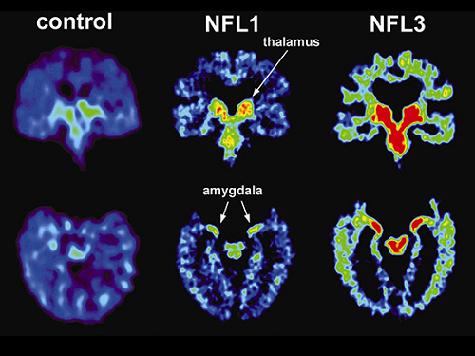On Tuesday, a UCLA study that found evidence of brain damage in five living retired NFL players was published in the American Journal of Geriatric Psychiatry.
The study used positron emission tomography (“PET”), a new patented scanning technology, to detect images of a protein known as “tau” in the brains of Fred McNeil, who played linebacker for a dozen years with Minnesota Vikings, Wayne Clark, a reserve quarterback who played with the San Diego Chargers in the early 1970s, and three other retired NFL players. The presence of “tau” in the brain indicates the existence of chronic traumatic encepholapathy (“CTE”).
One of the study’s authors, Dr. Gary Small, said “[i]f this research continues in the direction we expect, it would have a big impact on the early detection of this condition, helping us to develop interventions that could delay the onset of symptoms.”
A national recognized expert not associated with the study, Dr. Robert Cantu, co-director of Boston University’s Center for the Study of Traumatic Encephalopathy, was cautiously optimistic about the results of the study. “If indeed it is sensitive and specific enough for tau, it would be extremely exciting and hugely important, but this was only five players,” he told a medical publication.
The study was funded in part by the Brain Injury Research Institute, an organization co-founded by Dr. Bennet Omalu, who first found evidence of CTE in retired NFL players in 2002 when he examined the brain of deceased former Pittsburgh Steelers center Mike Webster. For several years, the NFL was highly critical of the work performed by Dr. Omalu and the Brain Injury Research Institute, but later acknowledged the possibility of a connection between football and brain injuries.
With news that the new PET scanning technology can detect evidence of CTE in living players, questions will arise about implementing a testing protocol for all current and retired players. Medical standards may be developed around measurements of “tau” protein presence in the brain and recommendations about a player’s health clearance to play in games. Both the NFL and the NFL Players Association are likely to be involved in lengthy discussions about what role–if any–PET scanning of current players will play in the 2013 season and beyond.
On Wednesday, a day after the release of the UCLA study, the family of former San Diego Chargers linebacker Junior Seau, who committed suicide in May, announced that it had filed a wrongful death lawsuit against the NFL. The family charged that the league hid evidence of the connection between playing football and brain injuries.

COMMENTS
Please let us know if you're having issues with commenting.